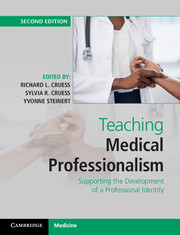Book contents
- Frontmatter
- Contents
- List of contributors
- Foreword
- Introduction
- Part I What is to be taught and learned
- Part II Theory
- 3 Theoretical insights into the nature and nurture of professional identities
- 4 Socialization, professionalism, and professional identity formation
- 5 Educational theory and strategies to support professionalism and professional identity formation
- 6 Role modeling and mentoring in the formation of professional identity
- 7 Experiential learning and reflection to support professionalism and professional identity formation
- Part III Principles
- Part IV Case studies in promoting professionalism and professional identity formation across the continuum
- Part V The future
- Index
- References
6 - Role modeling and mentoring in the formation of professional identity
from Part II - Theory
Published online by Cambridge University Press: 05 April 2016
- Frontmatter
- Contents
- List of contributors
- Foreword
- Introduction
- Part I What is to be taught and learned
- Part II Theory
- 3 Theoretical insights into the nature and nurture of professional identities
- 4 Socialization, professionalism, and professional identity formation
- 5 Educational theory and strategies to support professionalism and professional identity formation
- 6 Role modeling and mentoring in the formation of professional identity
- 7 Experiential learning and reflection to support professionalism and professional identity formation
- Part III Principles
- Part IV Case studies in promoting professionalism and professional identity formation across the continuum
- Part V The future
- Index
- References
Summary
The question for us as teachers is not whether but how we influence our students. It is a question about relationship: where are our students going and who are we for them on their journey?
Introduction
Role models and mentors are frequently spoken of in the same breath. Both play important roles in helping new and “becoming” members to develop and navigate their journey into the profession. Indeed, it might be argued that the influence of role models and mentors extends from well before the time one enters professional studies, right through a practice lifetime. There are clearly articulated differences between the roles and processes of mentor and role model. However, they are related functions, and may grow from similar philosophical positions. Both processes are dynamic and reciprocal, involving interactions and adaptive changes occurring in the developing professional.
Certain assumptions inform our exploration of these two processes. First, we have chosen a constructivist approach to understand both role modeling and mentoring. Constructivism refers to the way in which individuals build their own understanding and knowledge of the world through direct experience and reflection on experience. Constructivism focuses on meaning-making, on “making sense” both individually and collectively of our world.2 Such meaning-making is essential to our development as professionals. The processes of learning through role modeling and mentoring are not passive; in both, the learner actively forms an understanding of his or her own developing identity.
Our goals for this chapter are to:
• Explore the processes of role modeling and mentoring, to understand how they contribute to the formation of professional identity;
• Describe, based on the literature, how current understandings have evolved and how they align with understandings of how learning occurs; and
• Suggest and consider implications of the literature for educators, teachers, and learners, to enhance, support, and grow through these processes.
Two important shifts have occurred in the field of medical education, both of which highlight the importance of role modeling and mentoring. The first shift concerns what many would consider the core of our educational mission: creating the “professional” who, in addition to acquiring necessary skills and knowledge, will also adopt the values of the profession and enact them in an ethical, competent, and professional manner, based in mutually respectful interactions in the context of practice.
- Type
- Chapter
- Information
- Teaching Medical ProfessionalismSupporting the Development of a Professional Identity, pp. 84 - 96Publisher: Cambridge University PressPrint publication year: 2016
References
- 2
- Cited by



